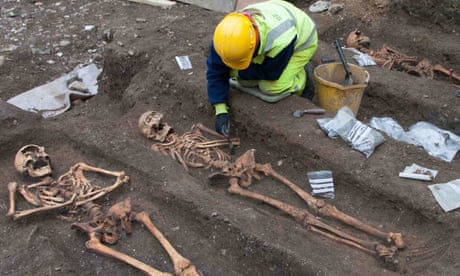Medieval clergy were more likely to suffer from intestinal parasites than the poorer public despite having better sanitation, research has found. Experts say those who dwelt in monasteries could have been at greater risk of such infections because they grew their own produce and may have used fresh human faeces as manure. “What we learn about the past is that just because you’re wealthier doesn’t mean to say you’re healthier,” said Dr Piers Mitchell, co-author of the study from the University of Cambridge .
The team say the study is the first to compare the prevalence of parasites in people leading different lives in the same location, allowing researchers to explore how lifestyle may have affected the risk of infections. Writing in the International Journal of Paleopathology , Mitchell and colleagues report how they used microsieving and digital light microscopy to analyse sediments from two burial sites in Cambridge for signs of parasites such as roundworm. These are found in faeces and spread through poor hygiene.
A roundworm egg recovered from a grave at All Saints by the Castle parish cemetery. Photograph: University of Cambridge The burials included 19 graves of clergy buried at an Augustinian friary between the 13th and 16th centuries, and 25 adult burials from the All Saints by the Castle parish cemetery – where poorer people including agricultural workers were buried – from between the 10th and 14th centuries. The researchers deemed an infection genuine if parasite eggs were only found near the pelvis, where they would be expected once the intestines decomposed, or if such egg counts were at least four times higher than for samples from the head or feet – where parasite eggs may have been present because of contaminated soil falling into the grave.
The latter, said Mitchell, is a possibility given many poorer people would simply have emptied their bowels, or waste-containing pots, on to a patch of ground – though cesspits were also used. Sign up to First Edition Free daily newsletter Archie Bland and Nimo Omer take you through the top stories and what they mean, free every weekday morning Privacy Notice: Newsletters may contain info about charities, online ads, and content funded by outside parties. For more information see our Privacy Policy .
We use Google reCaptcha to protect our website and the Google Privacy Policy and Terms of Service apply. The results reveal that parasite eggs were almost twice as common among the friars than ordinary people, with 58% of the former and 32% of the latter infected. “All 19 positive individuals had roundworm, while one friar also had whipworm,” the team write, although they add that the figures are likely to be underestimates.
The team say the disparity probably reflects a genuine difference between the two groups, noting the burial sites are geographically close enough, and the dates of the graves near enough in time, that the finding is unlikely to be down to differences in preservation of the eggs. While parasites were a fact of life in medieval times – even Richard III may have had roundworm – the team say the prevalence of worms among the friars was far higher than expected. “Monasteries were built with a sort of set plan in the medieval period: there are lots of stone buildings, they would have had latrine blocks, they would have had running water, they did hand washing,” said Mitchell, although excavations at the friary have not yet been carried out for such facilities.
As a result, he said, the team expected intestinal parasites to be less common among the friars than poorer townspeople. Mitchell said one explanation for the results was that the friars may have used their fancy toilet facilities as a source of fresh human waste to be used as fertiliser for crops in their gardens, adding that they could also have bought human or pig waste for the purpose. Should this have contained parasites, they would have been at risk of becoming infected when they ate their produce.
Mitchell added that medieval people thought intestinal worms were linked to having too much phlegm, one of the four “humours”. “They wouldn’t have understood that washing would be a healthy thing to decrease the risk of spreading infection. ” Dr Martin Heale, reader in medieval history at the University of Liverpool, who was not involved in the work, said friars did grow some of their own food – sometimes hiring gardeners to assist them – but noted they were supposed to live by begging.
“Therefore, much of their food probably came from charitable donations,” he said. “Perhaps stingy townspeople were giving them cheaper or unhealthier food than they ate themselves. Monasteries were also pretty contagious places, and used shared latrines, and that could be another factor once infection set in.
”.
From: theguardian
URL: https://www.theguardian.com/science/2022/aug/19/diy-fertiliser-may-be-behind-monk-parasite-torment-say-archaeologists-cambridge



